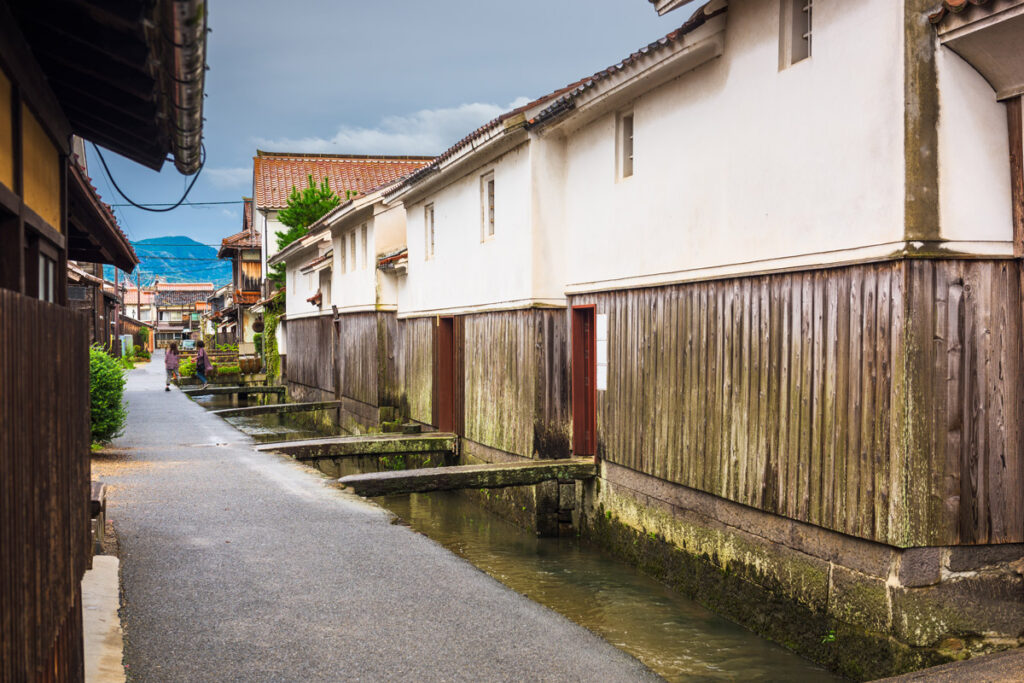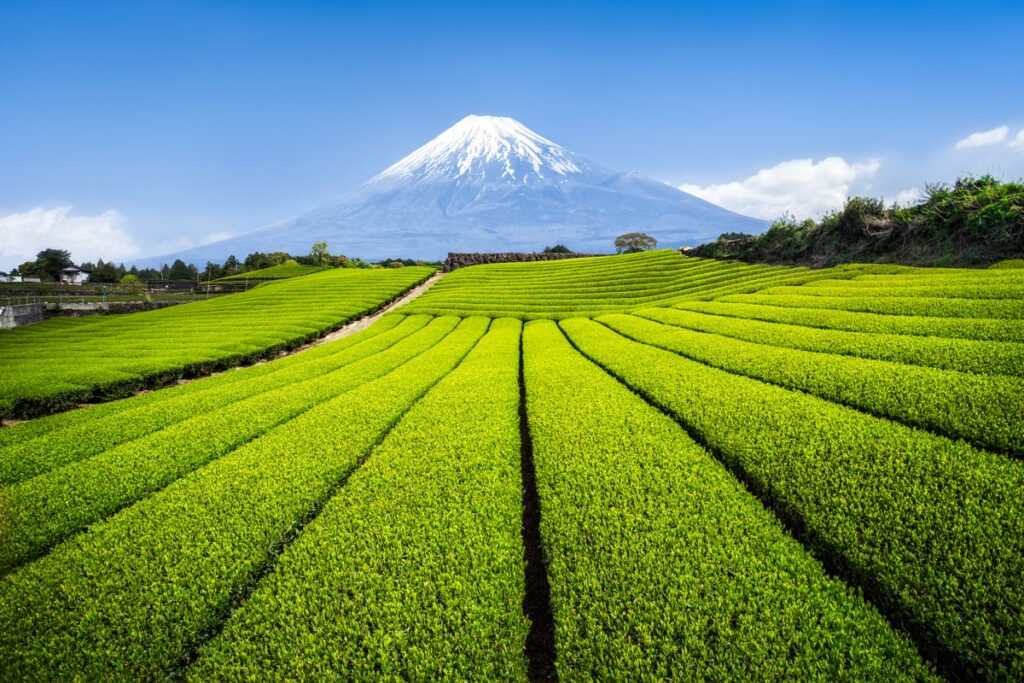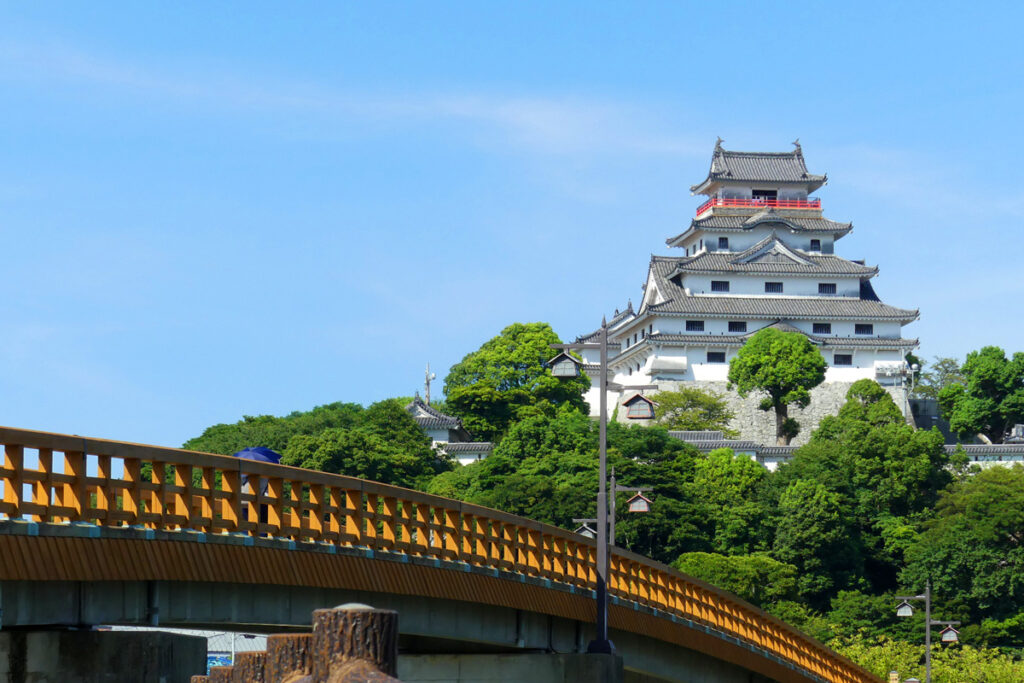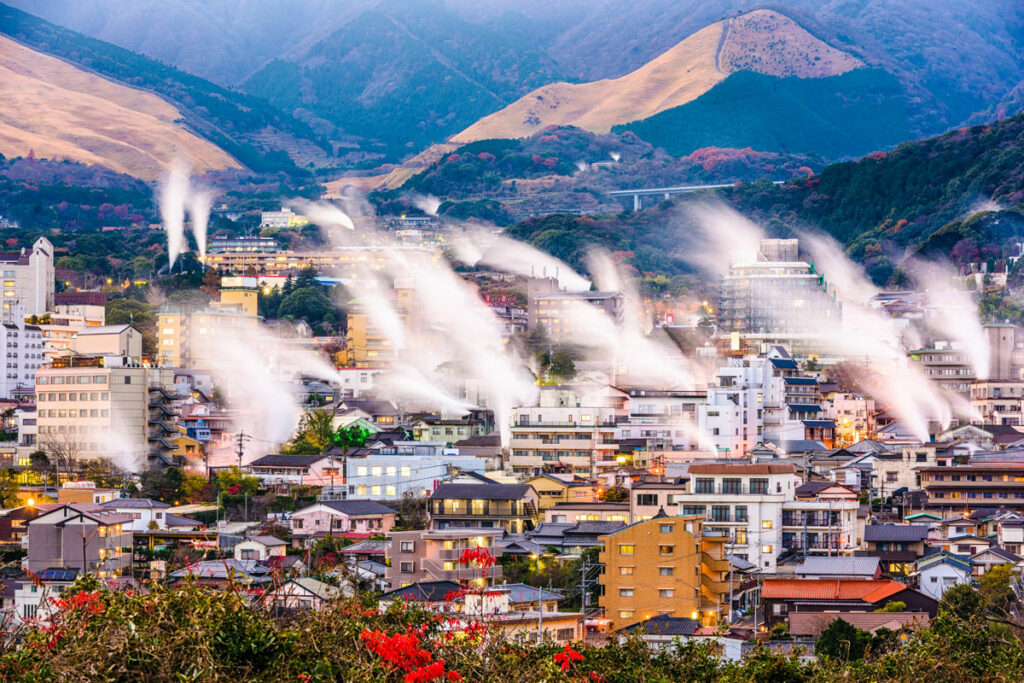Welcome to the vibrant heart of Japan’s Kanto Region! Just a stone’s throw away from the bustling metropolis of Tokyo, Ibaraki offers a refreshing escape that beautifully contrasts the urban jungle. It is is often overlooked by tourists in favor of more well-known destinations like Tokyo and Kyoto. From serene gardens to majestic historical sites, Ibaraki is a treasure trove of experiences waiting to be explored. If you’re wondering where to start, you’re in luck! We’ve curated a list of the 12 Top-Rated Things to do in Ibaraki. So whether you’re a seasoned traveler or someone looking to venture beyond Tokyo’s borders for the first time, this guide promises to make your Ibaraki journey truly unforgettable. Dive in and discover the magic that lies just beyond Tokyo’s bordering territories!
- 1. Hitachi Seaside Park
- 2. Oarai Isosaki Shrine
- 3. Tsukuba Science City
- 4. Mount Tsukuba
- 5. Suigo Itako Ayame Garden
- 6. Ushiku Daibutsu Buddha Statue
- 7. Fukuroda Falls
- 8. Kairakuen Garden
- 9. Kashima Shrine
- 10. Hitachi Civic Center
- 11. Art Tower Mito
- 12. Mito Castle
- Where to Stay in Ibaraki for Sightseeing
- Frequently Asked Questions (FAQs)
1. Hitachi Seaside Park
A sprawling park known for its seasonal flowers, especially the blue nemophila in spring

Hitachi Seaside Park is a must-visit for any traveler to Ibaraki Prefecture. This 190-hectare park is home to a stunning variety of flowers, which bloom in different seasons. In spring, the park is filled with blue nemophila flowers, creating a sea of blue. In summer, the kochia shrubs turn a fiery red. In fall, the leaves of the maple trees turn a brilliant red and orange.
In addition to its beautiful flowers, Hitachi Seaside Park also has a number of other attractions, including a Ferris wheel, a playground, and a golf course. There are also a variety of restaurants and cafes in the park, so you can enjoy a bite to eat while you’re there. The best time to visit Hitachi Seaside Park depends on the flowers you want to see. The nemophila flowers bloom in late April to early May, the kochia shrubs bloom in late July to early August, and the maple trees bloom in late October to early November.
Hitachi Seaside Park is located in Hitachinaka City, Ibaraki Prefecture. It is about an hour’s drive from Tokyo by car. The park is also accessible by public transportation. Hitachi Seaside Park is a beautiful and relaxing place to spend a day. Whether you’re a fan of flowers or just looking for a place to enjoy the outdoors, this park is sure to please.
Official Website: https://hitachikaihin.jp/
Address: 312-0012 Ibaraki, Hitachinaka, Mawatari, 字大沼605-4
Reviews Visit: TripAdvisor
2. Oarai Isosaki Shrine
A historic shrine with a serene ambiance, overlooking the Pacific Ocean
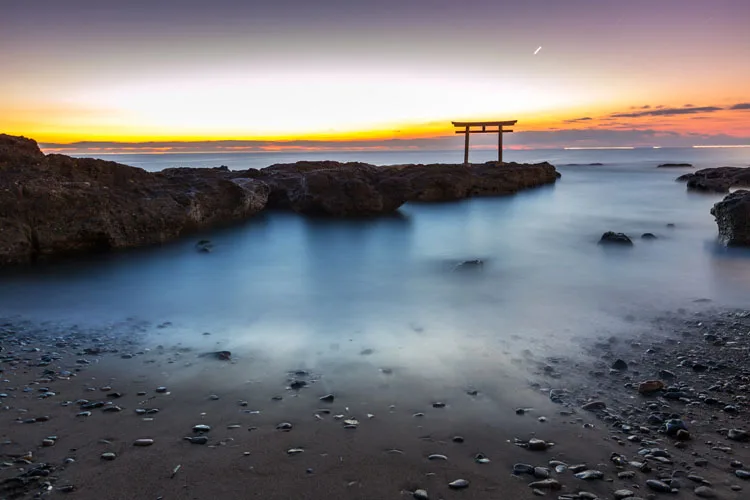
Oarai Isosaki Shrine is a Shinto shrine located in Oarai, Ibaraki Prefecture, Japan. It is dedicated to the god of the sea, and is a popular destination for fishermen and sailors. The shrine is also known for its beautiful beach, which is a popular spot for swimming and sunbathing. Located in the coastal town of Oarai in Ibaraki Prefecture, this shrine offers more than just spiritual solace; it provides a panoramic view of the vast Pacific Ocean, making it a unique blend of nature and tradition.
The shrine is said to have been founded in 856 AD. The main shrine building is located on a hill overlooking the Pacific Ocean. The shrine has three torii gates, the most famous of which is Kamiiso-no-Torii, which stands on rocks in the ocean. This gate is a popular spot for photography, and is said to be a good place to pray for good luck in fishing and sailing.
Oarai Isosaki Shrine is also known for its frog statues. These statues are placed at the entrance to the shrine, and are said to bring good luck and prosperity. The word “kaeru” in Japanese can mean both “frog” and “return home”, so the frogs are seen as a symbol of safe return.
The shrine is open all year round, and is a popular place to visit for both locals and tourists. If you are interested in Japanese culture or history, or if you are simply looking for a beautiful place to visit, Oarai Isosaki Shrine is definitely worth a visit.
Official Website: https://www.oarai-isosakijinja.net/
Address: 6890 Isohamacho, Oarai, Higashiibaraki District, Ibaraki 311-1301
Reviews Visit: TripAdvisor
3. Tsukuba Science City
The hub of scientific research in Japan, offering a glimpse into the country’s technological advancements.
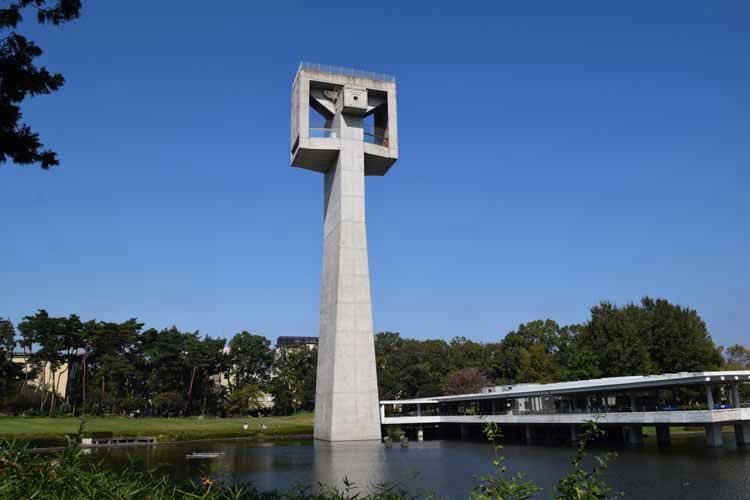
Tsukuba Science City is a planned city in Ibaraki Prefecture, Japan. This city is not just a place; it’s a vision of progress, innovation, and the relentless pursuit of knowledge. As the epicenter of Japan’s scientific research, it’s where ideas come to life and dreams take flight. It was established in 1963 as a national project to promote scientific research and development. The city is home to a number of leading universities and research institutions, including the University of Tsukuba, the National Astronomical Observatory of Japan, and the High Energy Accelerator Research Organization (KEK).
But it’s not all about labs and research papers. Tsukuba Science City has been designed with the traveler in mind. Interactive museums, such as the Tsukuba Expo Center, offer hands-on experiences, making complex scientific concepts accessible to all. Here, you can witness the marvels of space exploration, robotics, and cutting-edge technologies that are shaping our world. Tsukuba Science City is also home to a number of science museums and attractions, including the National Museum of Emerging Science and Innovation, the Tsukuba Space Center, and the Tsukuba Botanical Garden.
The city is well-connected to Tokyo by train and highway, and is a popular destination for day trips and weekend getaways. If you are interested in science and technology, or if you are simply looking for a place to escape the hustle and bustle of Tokyo, Tsukuba Science City is definitely worth a visit.
Detailed PDF: Tsukuba Science City
4. Mount Tsukuba
A twin-peaked mountain offering breathtaking views of the surrounding areas, especially during sunrise and sunset.
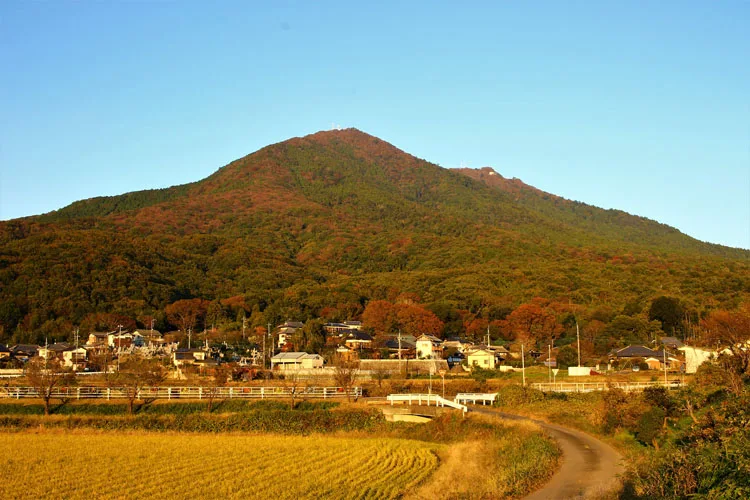
Mount Tsukuba is a sacred mountain located in Ibaraki Prefecture, Japan. It is the highest mountain in the prefecture, with an elevation of 1,965 meters (6,446 feet). The mountain is a popular destination for hiking, camping, and religious pilgrimage.
Mount Tsukuba is said to be the home of three gods: the god of heaven, the god of earth, and the god of the sea. The mountain is also associated with the Shinto goddess of the sun, Amaterasu. There are three peaks on Mount Tsukuba: Nantai-san, Akagi-san, and Jinba-san. Nantai-san is the highest peak and is the most popular destination for hikers. Akagi-san is the second highest peak and is known for its beautiful views of the surrounding area. Jinba-san is the lowest peak and is a popular spot for camping and picnicking.
Hikers and nature enthusiasts flock to Mount Tsukuba, drawn by the promise of unparalleled vistas. As you ascend its well-trodden paths, the world below unfolds in a tapestry of colors and textures. The best time to climb Mount Tsukuba is during the spring and fall, when the weather is mild. The mountain is also open for climbing in the winter, but it can be icy and dangerous. If you are looking for a challenging hike with stunning views, Mount Tsukuba is definitely worth a visit.
Website: https://www.mt-tsukuba.com/global/en/
Reviews Visit: TripAdvisor
5. Suigo Itako Ayame Garden
A picturesque garden renowned for its vibrant iris blooms during the summer season.
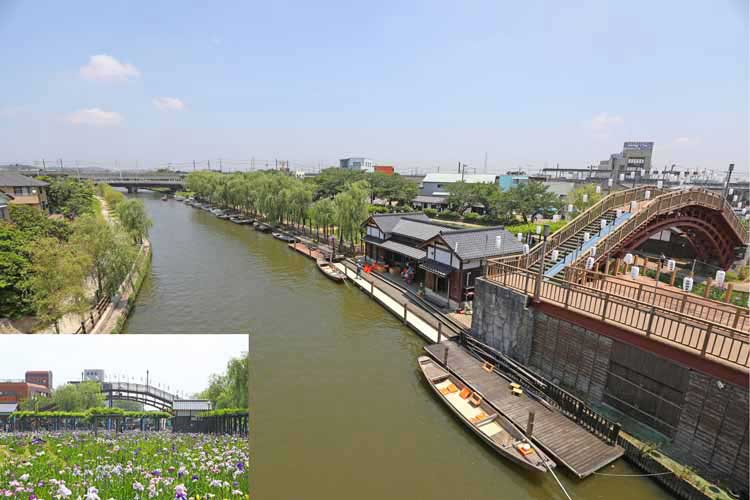
Suigo Itako Ayame Garden is a must-visit for any traveler to Ibaraki Prefecture in spring. This 16-hectare garden is home to over 200,000 irises, which bloom in late April to early May. The garden is also a popular spot for bird watching. The irises in the garden are of all colors, including blue, purple, yellow, and white. They are planted in neat rows and flower beds, creating a stunning sight. The garden is also home to a number of other plants, including lotus flowers, water lilies, and bamboo.
In addition to its beautiful flowers, Suigo Itako Ayame Garden also has a number of other attractions, including a pond, a teahouse, and a souvenir shop. There are also a variety of restaurants and cafes in the area, so you can enjoy a bite to eat while you’re there.
The best time to visit Suigo Itako Ayame Garden is during the peak bloom season for the irises, which is late April to early May. Suigo Itako Ayame Garden is a beautiful and relaxing place to spend a day. Whether you’re a fan of flowers or just looking for a place to enjoy the outdoors, this garden is sure to please.
Address: 1-chome-5 Ayame, Itako, Ibaraki 311-2425
Reviews Visit: TripAdvisor
6. Ushiku Daibutsu Buddha Statue
One of the tallest Buddha statues in the world, with an observation deck offering panoramic views.
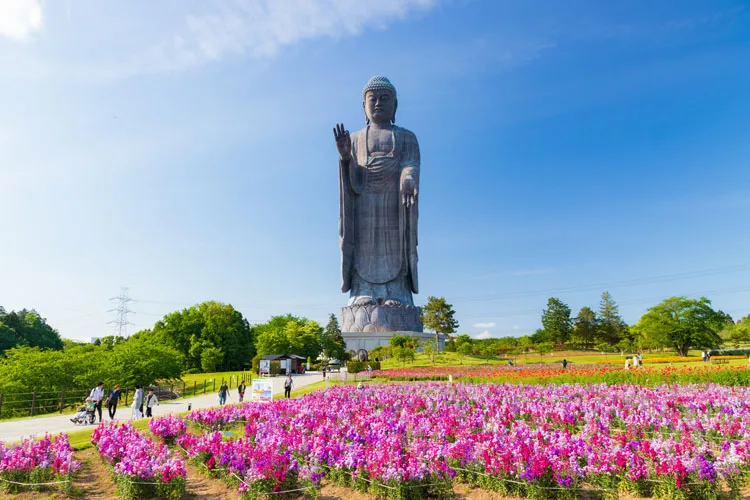
Ushiku Daibutsu is a bronze statue of Amida Buddha located in Ushiku, Ibaraki Prefecture, Japan. Towering over the landscape, this awe-inspiring statue is not just a marvel of artistry and architecture but also ranks among the tallest Buddha statues in the world, standing at 120 meters (394 feet) tall. The statue was completed in 1993 and is dedicated to Shinran, the founder of the Jodo Shinshu sect of Buddhism.
The statue is made of 2,043 tons of bronze and is hollow. The majesty of Ushiku Daibutsu isn’t limited to its exterior. Inside, a series of elevators transport visitors to an observation deck nestled within the statue. From this vantage point, one can witness panoramic views that stretch across the horizon, encompassing the lush Japanese countryside, urban skylines, and on clear days, even the distant mountains. The statue is surrounded by a park with gardens, ponds, and a museum.
Ushiku Daibutsu is a popular tourist destination and is a must-see for any visitor to Ibaraki Prefecture.
Official Website: https://daibutu.net/
Address: 2083 Kunocho, Ushiku, Ibaraki 300-1288
Reviews Visit: TripAdvisor
7. Fukuroda Falls
A majestic four-tiered waterfall, especially beautiful during the autumn foliage season.
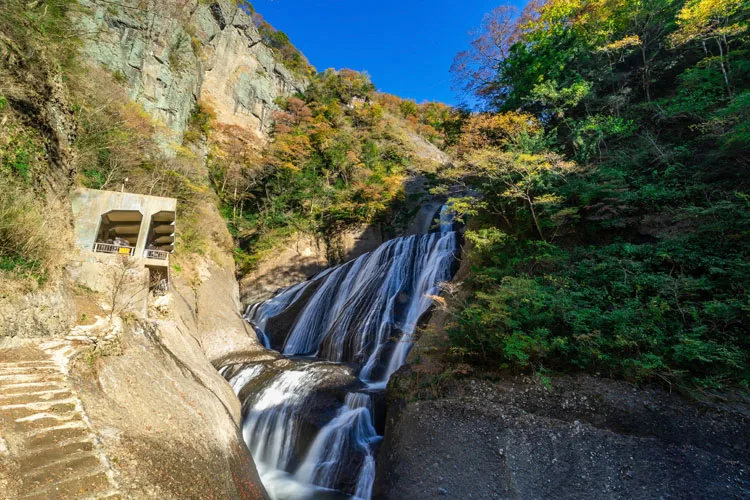
Fukuroda Falls is a series of four waterfalls located in Daigo, Ibaraki Prefecture, Japan. The falls are the tallest in Ibaraki Prefecture, with a total height of 120 meters (394 feet). The falls are located in a scenic valley and are surrounded by lush forests.
The name “Fukuroda” means “many falls” in Japanese. The falls are divided into four sections: the Upper Falls, the Middle Falls, the Lower Falls, and the Nachi Falls. The Upper Falls are the tallest section of the falls, with a height of 70 meters (230 feet). The Middle Falls are 50 meters (164 feet) tall, the Lower Falls are 30 meters (98 feet) tall, and the Nachi Falls are 10 meters (33 feet) tall.
While Fukuroda Falls is a sight to behold throughout the year, it truly transforms during the autumn foliage season. As the leaves change hues, painting the landscape in shades of crimson, gold, and amber, the waterfall becomes the centerpiece of this natural masterpiece. The reflection of the vibrant leaves in the pools below, juxtaposed with the pristine white of the cascading waters, creates a spectacle that has inspired poets, artists, and travelers for generations.
Fukuroda Falls are a popular tourist destination and are a must-see for any visitor to Ibaraki Prefecture. The falls are best visited during the spring and fall, when the weather is mild and the water levels are high.
Official Website: https://www.daigo-kanko.jp/
Address: 3-19 Fukuroda, Daigo, Kuji District, Ibaraki 319-3523
Reviews Visit: TripAdvisor
8. Kairakuen Garden
One of the Three Great Gardens of Japan, famous for its plum blossom festival.
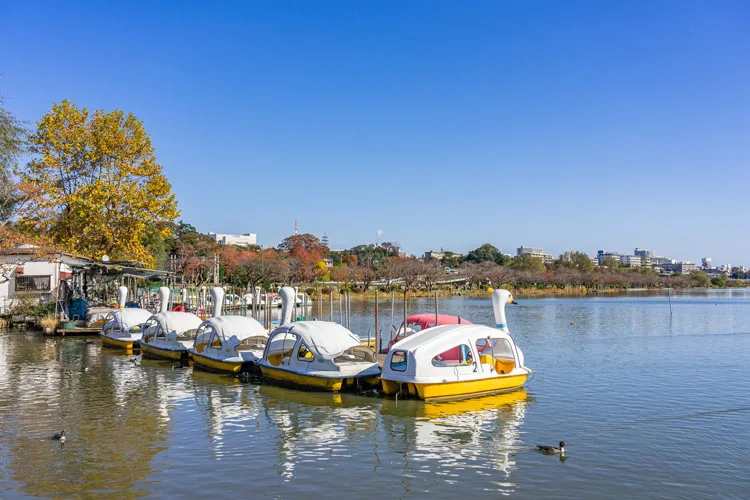
Beyond the festival, Kairakuen offers tranquil spots for reflection, historical landmarks, and tea houses where one can savor traditional Japanese tea ceremonies. A visit to Kairakuen Garden is a journey through time, nature, and the soul, promising memories that linger long after the blossoms have fallen.
Kairakuen Garden is one of the Three Great Gardens of Japan, along with Kenrokuen Garden in Kanazawa and Korakuen Garden in Okayama. It is located in Mito, Ibaraki Prefecture, and was created in the 18th century by the daimyo of Mito, Tokugawa Nariaki. The garden is famous for its beautiful cherry blossoms, which bloom in late March to early April. It also has a variety of other plants, including maple trees, azaleas, and rhododendrons. As winter wanes and spring whispers its arrival, the garden bursts into a riot of colors, with over 3,000 plum trees showcasing their vibrant blooms. The air is filled with the sweet fragrance of these blossoms, creating an atmosphere that is both enchanting and rejuvenating.
Kairakuen Garden is divided into three parts: the inner garden, the middle garden, and the outer garden. The inner garden is the most formal part of the garden and is home to the main teahouse. The middle garden is more relaxed and is a popular spot for picnicking. The outer garden is the largest part of the garden and is home to a variety of plants and trees.
Kairakuen Garden is a popular tourist destination and is a must-see for any visitor to Ibaraki Prefecture.
Official Website: https://ibaraki-kairakuen.jp/en/
Address: Kairakuen, Mito, Ibaraki
Reviews Visit: TripAdvisor
9. Kashima Shrine
A historic Shinto shrine with a rich history and beautiful architecture.
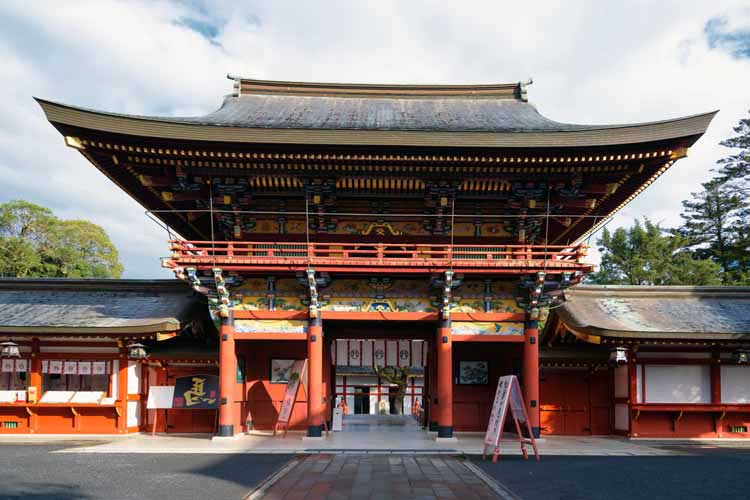
Kashima Shrine is one of the oldest and most important Shinto shrines in Japan. It is located in Kashima, Ibaraki Prefecture, and is dedicated to the god Kashima, who is the god of war and agriculture.
The shrine is said to have been founded in the 3rd century BC, and has been patronized by many Japanese emperors and shoguns. It is also one of the Three Grand Shrines of Kanto, along with Ise Grand Shrine and Kasuga Grand Shrine.
The shrine is known for its beautiful architecture, which is a combination of Japanese and Chinese styles. The main shrine building is a two-story structure with a thatched roof. The shrine also has a number of other buildings, including a museum, a teahouse, and a garden.
Kashima Shrine is a popular tourist destination and is a must-see for any visitor to Ibaraki Prefecture. Kashima Shrine is a beautiful and spiritual place. Whether you’re a fan of Japanese culture or just looking for a place to connect with nature, this shrine is sure to please.
Official Website: https://kashimajingu.jp/
Address: 2306-1 Kyuchu, Kashima, Ibaraki 314-0031
Reviews Visit: TripAdvisor
10. Hitachi Civic Center
Hitachi Civic Center: A museum dedicated to the history and culture of Ibaraki prefecture.
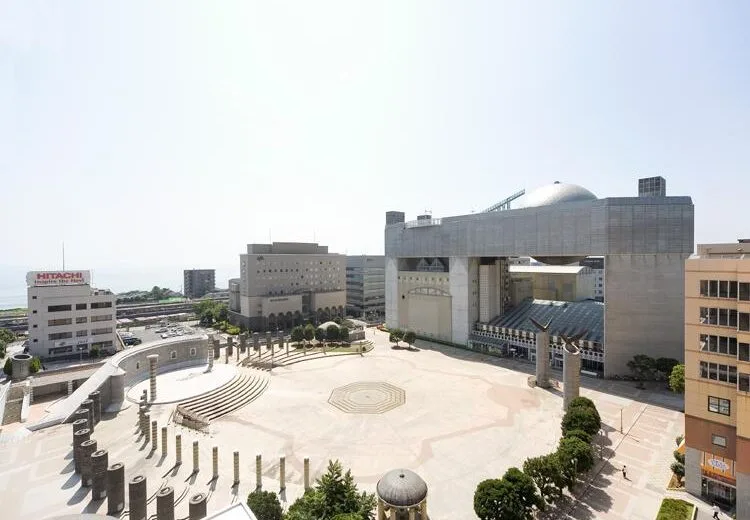
Hitachi Civic Center is a multi-purpose complex located in Hitachi, Ibaraki Prefecture, Japan. It is home to a concert hall, an art museum, a library, and a theater. The center is a popular venue for performances, exhibitions, and other events.
The concert hall is a 1,800-seat auditorium that is used for a variety of performances, including classical music concerts, jazz concerts, and opera performances. The art museum has a collection of Japanese and Western art, including paintings, sculptures, and ceramics. The library has a collection of books, magazines, and newspapers in Japanese and English. The theater is a 500-seat auditorium that is used for plays, musicals, and other performances.
Hitachi Civic Center is a popular destination for both locals and tourists. It is a great place to enjoy a variety of arts and cultural events. Hitachi Civic Center is a great place to spend a day or evening. Whether you’re interested in arts and culture or just looking for a place to relax and enjoy a performance, Hitachi Civic Center is sure to please.
Website: https://www.city.mito.lg.jp/
Address: 1 Chome-21-1 Saiwaicho, Hitachi, Ibaraki 317-0073
Reviews Visit: TripAdvisor
11. Art Tower Mito
Looking for a unique and fascinating destination in Mito, Japan? Look no further than Art Tower Mito, a stunning structure that celebrates and promotes the arts and culture of the region.
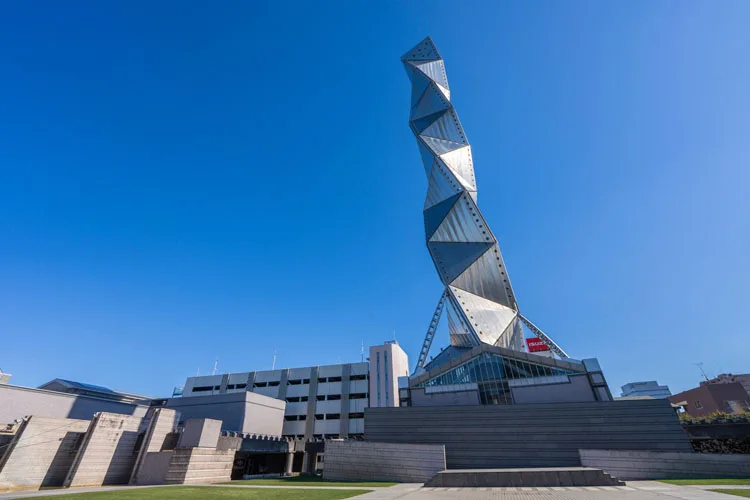
Art Tower Mito is a multi-purpose cultural complex located in Mito, Ibaraki Prefecture, Japan. The tower is a popular destination for both locals and tourists. This iconic structure, with its spiraling design, is not just an architectural marvel but also a hub for the arts, encompassing music, theater, , performance spaces, a library and visual arts under one roof.
The tower was designed by architect Kisho Kurokawa and was completed in 1990. It is 100 meters tall and has a spiral staircase that winds its way up to the top. The tower is made of concrete and glass, and its design is inspired by the traditional Japanese pagoda.
The art galleries in Art Tower Mito host a variety of exhibitions, including Japanese and international art. The performance spaces host a variety of performances, including concerts, plays, and dance performances. The library has a collection of books, magazines, and newspapers on a variety of topics.
Art Tower Mito is a popular destination for both locals and tourists. It is a great place to enjoy a variety of cultural events. Art Tower Mito is a great place to spend a day or evening. Whether you’re interested in art, culture, or just looking for a place to relax and enjoy the view, Art Tower Mito is sure to please.
Official Website: https://www.arttowermito.or.jp/
Address: 1 Chome-6-8 Gokencho, Mito, Ibaraki 310-0063
Reviews Visit: TripAdvisor
12. Mito Castle
Mito Castle: A historic castle that dates back to the Edo period.
Mito Castle, also known as Kairakuen Castle, is a historic castle located in the city of Mito, Ibaraki. The castle dates back to the Edo period, and it’s a great destination for history buffs and those interested in traditional Japanese architecture. The Mito Castle was built in 1620 by the Tokugawa Clan, during the Edo period and it was used as a residence for the ruling clan.
Mito Castle is a national treasure of Japan. It is located in Mito, Ibaraki Prefecture, and was built in the 17th century. The castle is a five-story structure with a wooden keep. It is surrounded by a moat and a stone wall.
The castle was built by the Tokugawa clan, who ruled Japan during the Edo period (1603-1868). The castle was used as a military headquarters and a residence for the Tokugawa family.
Mito Castle was restored in the early 20th century. It is now a popular tourist destination. Visitors can tour the castle and learn about its history. Mito Castle is a beautiful and historic castle. It is a great place to learn about Japanese history and culture.
Website: https://www.city.mito.lg.jp/
Address: 2 Chome-9 Sannomaru, Mito, Ibaraki 310-0011
Reviews Visit: TripAdvisor
Where to Stay in Ibaraki for Sightseeing
Whether you’re looking for luxury accommodations, mid-range options, or budget-friendly hotels, Ibaraki has something to suit every traveler’s needs. Here are some top picks:
Luxury Stay:
KAMENOI HOTEL OARAI : It is a ryokan (traditional Japanese inn) located in Oarai, Ibaraki. It is a short walk from Oarai Isosaki Shrine, a popular tourist destination. The hotel has a hot spring bath, a Japanese garden, and a restaurant serving traditional Japanese cuisine. A luxurious retreat that offers a blend of modern amenities with traditional Japanese aesthetics. Located close to the Oarai Isosaki Shrine, it’s an ideal choice for travelers looking to immerse themselves in Ibaraki’s rich history while enjoying top-notch facilities.
KAMENOI HOTEL KUJUKURI : It is another ryokan located in Kujukuri Beach, Ibaraki. It is a 10-minute walk from the beach and has a hot spring bath, a Japanese garden, and a restaurant serving fresh seafood. Experience the essence of Japanese hospitality at this Ryokan. With its serene ambiance and proximity to the Pacific Ocean, it’s perfect for those seeking a tranquil escape amidst the beauty of Ibaraki.
Mid-Range Stay:
Hotel Hitachi Plaza: It is located in Hitachinaka, Ibaraki, near the Hitachi Seaside Park. It has a swimming pool, a fitness center, and a restaurant serving Western and Japanese cuisine. A comfortable and contemporary stay option, this hotel is strategically located near some of Ibaraki’s prime attractions, including the Hitachi Civic Center. Its warm hospitality and convenient location make it a favorite among travelers.
Hotel Lifetree Hitachinoushiku: It is located in Hitachi, Ibaraki, near the Hitachinaka Flower Park. It has a hot spring bath, a fitness center, and a restaurant serving buffet breakfast. This hotel offers a cozy stay experience. Its central location ensures easy access to key sightseeing spots, making it a great base for exploring Ibaraki.
Budget Hotels Stay:
Sannomaru Hotel : It is located in Mito, Ibaraki, near the Mito Plaza. It has a shared lounge and a restaurant serving Japanese cuisine. Breakfast is included in the price. A budget-friendly option that doesn’t compromise on comfort. Located near the historic Mito Castle, guests can start their day with a complimentary breakfast before heading out for a day of exploration.
APA Hotel Mito Ekimae : APA Hotel Mito Ekimae is located in Mito, Ibaraki, near the Mito Station. Breakfast is included in the price.Offering a blend of affordability and convenience, this hotel is situated close to Kairakuen Garden. After a day of sightseeing, guests can look forward to a hearty breakfast to kickstart their next adventure.
Frequently Asked Questions (FAQs)
Where is Ibaraki located in Japan?
Ibaraki is situated in the Kanto Region of Japan. It’s strategically located to the northeast of Tokyo, making it a convenient destination for travelers looking to explore areas bordering the capital city.
What are the top attractions in Ibaraki?
Ibaraki boasts a diverse range of attractions, from historical sites to natural wonders. Some of the top-rated things to do include visiting the Kairakuen Garden, exploring the Mito Castle, and experiencing the beauty of the Fukuroda Falls, among others.
How can I reach Ibaraki from Tokyo?
Ibaraki is easily accessible from Tokyo. Travelers can take express trains or buses from major Tokyo stations, and the journey typically takes less than two hours, making it a perfect destination for day trips or weekend getaways.
Is Ibaraki a good destination for families?
Absolutely! Ibaraki offers a plethora of family-friendly attractions, including parks, museums, and cultural sites. Its proximity to Tokyo also makes it a convenient choice for families looking for a quick escape from the city’s hustle and bustle.
When is the best time to visit Ibaraki?
Ibaraki is beautiful year-round, but many travelers prefer visiting during the spring for the cherry blossoms or during the autumn for the vibrant fall foliage. However, each season offers unique attractions, ensuring a memorable experience whenever you choose to visit.

